Summary
The purpose of this webpage is to assist the representative taxpayers of Trusts with the completion and submission of the Income Tax Return for Trust (ITR12T) via SARS eFiling. The webpage is structured as follows; firstly, the eFiling Channel is described, elaborating how to register and login to eFiling. The webpage explains the functions embedded in the system and how they can be used for submission purposes.
The most common reasons for creating a Trust are:
- To protect assets for minor children or disabled relatives;
- For Estate planning purposes; and
- As a mechanism to protect assets from creditors.
A Trust is created by a founder, and is governed by a Trust deed, which stipulates, inter alia the beneficiaries, the Trustees, and the terms of the deed. It is formed in various ways based on the nature and type of the Trust. The nature of a Trust may differ in one of the following ways:
- In their method of formation namely, during the lifetime of a person or upon his death under a will.
- In the rights, they confer on beneficiaries. Under a vesting Trust, the beneficiaries have a vested right to the income and/or capital of the Trust. Under a discretionary Trust, the Trustsees have the discretion as to whether and how much of the income or capital of the Trust to distribute to the beneficiaries.
- In their purpose, namely trading Trust, asset protection Trust, charitable Trust, or Special Trust. Two types of Special Trust exist for income tax purposes:
- A (Type A) Trust is created for the benefit of a person with a disability.
- A (Type B) Trust is created under the will of a person for the benefit of his relatives.
Trusts are taxed in terms of section 2(1) of the Rates and Monetary Amounts and Amendment of Revenue Laws Act 2013. This is with the exception of a “Special Trust” which is defined in section 2(1) of the Act. As from 1 March 2017, Trusts other than Special Trusts are taxed at a rate of 45%. Revenue generated from a Trust can either be retained, distributed to the beneficiaries or profits can be deemed to have been received by another person in terms of section 7 of the Income Tax Act. This income becomes taxable in the hands of the person who receives it. The tax implications of the Trust and beneficiaries are based on section 25B and section 7 of the Income Tax Act. With reference to the Conduit Pipe Principle, revenue distributed from a Trust retains its identity unless (under some circumstances) it is regarded as an annuity.
The source and nature of the income, the method of transfer of the assets to the Trust as well as the status of all the relevant parties have an impact on the tax implications in respect of the receipts or accruals of income by the Trustsees. This revenue and additional required information must be recorded accurately on the Trusts (ITR12T) return and submitted to SARS.
- A Trust fund consists of cash or other assets which are administrated and controlled by a person acting in a fiduciary capacity, where such person is appointed under a deed of Trust, by agreement or under the will of a deceased person.
- SARS has enhanced the Trusts tax process systems and aligned it to ITR12 for a more accurate submission and a simplified tax process. One such improvement is regarding the ITR12T return.
- The ITR12T return has been enhanced to HTML so that it is more dynamic and user friendly. Furthermore, some of the fields are pre-populated with third party data for ease in the completion of the return.
SARS values your contribution as taxpayers and your readiness in fulfilling your tax responsibilities, thus we are constantly enhancing our processes to ensure that the tax systems are functioning optimally and effectively so you can be confident in the process. Being able to complete and submit your Trusts return via eFiling is one such improvement and this webpage will assist you.
Describing the SARS eFiling System
Overview
- SARS eFiling is a free, electronic service that allows individual taxpayers, tax practitioners and businesses to submit tax returns, make payments and interact with SARS in a secure online environment from the comfort and convenience of their home or office. To access this software, you must be registered. Once registered, eFilers can submit returns, view their tax status, and make payments to SARS electronically 24 hours a day.
- SARS has introduced a Live Chat functionality on eFiling – a software technology that allows taxpayers to communicate directly with a SARS service agent in real-time. SARS clients can chat with a SARS service agent via eFiling, instead of having to resolve their tax issues by calling the SARS voice channels, visiting a SARS office, or even sending an e-mail. The Live Chat service on eFiling doesn’t require you to login or download any software to start chatting.

- SARS eFiling also provide a chatbot, Lwazi, by selecting the “Ask A Question” tab to provide an instant support experience and automated answers to general queries.

Benefits of using eFiling
eFilers are given more time to make their submissions.
- Tax representatives can save the ITR12T form and submit it later, which will give them more time to review the information to be submitted to SARS.
eFilers have a full history of all submissions, payments, and electronic correspondence available at a click of a button.
- The system allows a tax representative to view the history of submissions made of the ITR12T form on the system for their convenience.
eFilers can receive SMS and email notifications to remind them when submissions are due.
- SMS and email notifications assist the tax representatives in the submission process by ensuring that the returns are submitted before the due date.
The simplicity of the process results in fewer errors and creates a quicker processing cycle for individuals and business.
- There are embedded functions within the ITR12T return such as pre-populating fields, pop up warning messages when incorrect information is completed and the simplified navigation. These functions will result in few errors during your return process.
eFilers can use the tax calculator function to receive a pre-assessment of their ITR12T submission before an original assessment is done.
- Tax representatives can access a pre-ITA34T before an original assessment is sent to assist them in determining accuracy of the information, which will be submitted to SARS.
Registration, Update Profile and Requesting ITR12T on eFiling
Overview
As described in the previous section, to access eFiling you must be registered as a tax representative/ tax practitioner and responsible for the submission of a specified Trust on the system. This section will take you through the registration process, how to activate a Trust on the system and further illustrate how to update your profile on eFiIing. Screenshots are applied to demonstrate the use of the system.
How to Register for the use of eFiling
- Navigate the website www.sars.gov.za, click ‘Register’ and follow the steps stipulated to complete the registration process.
- For further assistance with eFiling registration, refer to the “How to register for eFiling and Manage your user Profile” available on the SARS website.

- Once registered, click on “Login”, and complete your username. Once completed click on “Next” to proceed.
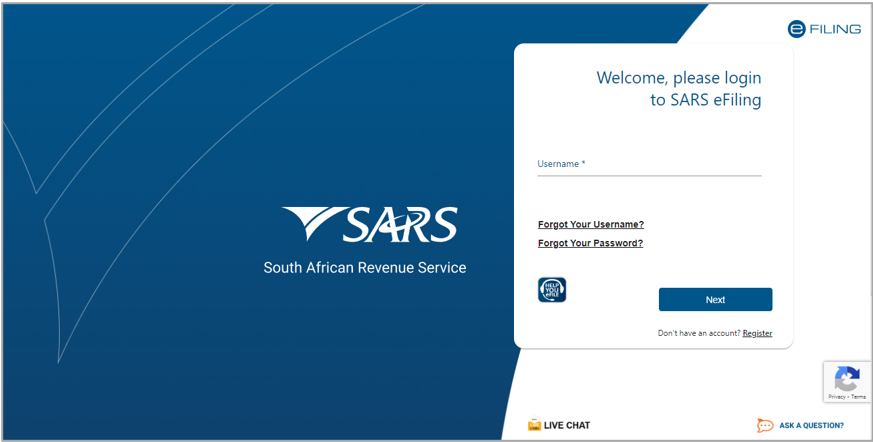
- Complete your password and click on the “Login” button.
How to Add a New Trust to the eFiling Profile
- Once you are successfully registered and successfully logged into your eFiling profile, proceed to activate the Trust before you are allowed to request and submit an ITR12T return. The below section will demonstrate how to activate a Trust on eFiling.
- Select “Organisations” on the left menu and then select “Register New”.

- The following screen will be displayed to the taxpayer to enable the capturing of ‘Entity Details’.

- Complete all the required information.

- Once all the fields have been completed, click the “Add Taxpayer” button to proceed.
How to Activate a Registered Trust
To activate a registered Trust, proceed as follows:
- Of the options below “Organisation” which are displayed on the left menu, click on “Tax Types” and “Manage Tax Types”.

- Select the action tick box next to the relevant tax product to activate the tax type and click the “Submit” button to proceed. Below is an example of how the screen looks.

How to Update User Rights on eFiling
- This section will illustrate how to identify those who have access to the Trust submission and further verify whether the Trust has been successfully registered.
- Click on “Right Groups” from the left side menu options.
- Select “Manage Groups”.

- The “Group Details” screen will be displayed. Click on the “Open” hyperlink to proceed.

- The “Update Group Details” screen will be displayed.

- Select the tax type (Organisation Income Tax ITR14/IT12EI/ITR12T) by checking the appropriate tick box. Click “Update” to submit.
How to Manage Users
To manage those in the group who have access to the Trusts submission proceed as follows:
- Click on “Right Groups” from the left side menu options.
- Select “Manage Groups”.
- The “Group Details” screen will be displayed.

- Select the hyperlink “Manage Users”.

- Ensure that the login name that you are logged in with is in the grey box on the right-hand side.
- To add after dragging and dropping the users in the grey box, click on the save button (floppy disk icon) to save the required changes.
How to Request an ITR12T Return
- Once you have registered and activated the Trust, you should be able to access the return. This section will assist you in accessing the return via eFiling.
- Click on “Returns” and “Returns issued” displayed on the menu options.
- Select “Income Tax (ITR14/ITR12T/ITR12EI)” displayed as one of the categories of the left side menu option “Returns Issued”.

- Select the appropriate period of submission from the drop-down list displayed on the right side of the screen. Click the “Request Return” button and the “Returns Search” screen will be displayed indicating the return issued.

Note that to terminate the Trust service, which is in the process of being deregistered, select a future return. The following message will be displayed to confirm the termination of the Trust services, which is in the process of being deregistered. Click “OK” to terminate the Trust and alternatively click “Cancel” to go back to the “Request Return” page.

- Below is the “Return Search” page that indicates the return that has been issued.

- When 2023 Tax year is selected, the following message will be presented:

- If the user clicks “OK”, then the return will be issued, and where “Cancel” is selected, the action will be cancelled, and the user returned to the search grid.
- Click the “Open” hyperlink and the “Income Tax Work Page” will be displayed.

- A verification message will be displayed to verify the banking, contact and trustee details.
- If all the information is the same as the previous year, click “Yes” or “Cancel” to close the message.
- Click on “No – Maintain Legal Entity Details now”, to verify and update any outdated legal entity information of the Trust representative i.e., contact details, physical address, postal address, banking details and other particulars. The “Maintain SARS Registered Details” will be displayed.

- When the option “I do not agree” is selected, the “Continue” button will be greyed out and the return will not open for the maintenance of SARS registered details. When “I agree” is selected, the Trust representative is duly authorised to perform Maintenance of SARS Registered Details on behalf of the company or individual.
- Refer to the external guide “How to complete the Registration amendments and Verification Form (RAV01)” for detailed information on how to confirm and verify the applicable company details. The guide can be accessed on www.sars.gov.za.
On the Income Tax Work Page, the following buttons will be displayed:
- Maintain Legal Entity Details – this will redirect you to the Legal Entity Registration function.
- Request Historic Documents – historic Notice of Assessments and Statements of Account may be requested by selecting this button.
- Refund Status – You will be able to check the refund status of the assessment if a refund is due to you.
- Refresh Return – this will request new pre-population of the return.
- Submitted at Branch – by selecting this button, eFiling will be updated to indicate that the return has been submitted through another channel, e.g., at a SARS Branch.
- Return Submission Dashboard – you will be presented with the return submission dashboard.
- Incorrect return type? – You will have the ability to change the return type if it is incorrect.
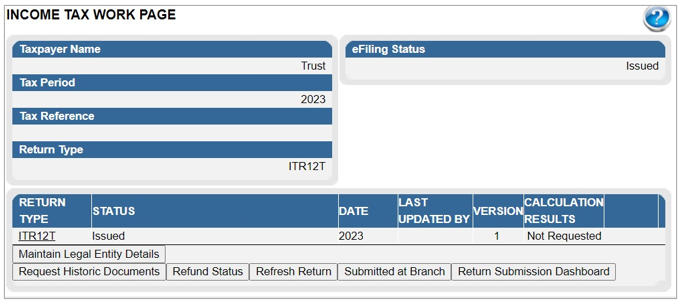
- Click on the “ITR12T” hyperlink to open the return for completion.
Step by Step Demonstration on the Completion and Submission of the ITR12T Return
Overview
This section will demonstrate how to complete and submit the ITR12T return by displaying step by step screen shots, which describe the process of submission and further highlight the details an eFiler should take into consideration whilst completing the return. Functions which may be used are also discussed and demonstrated for the ease and usage of eFiling.
Estimated Assessments
- Once the filing period for Trusts ends, SARS may raise original estimated assessments on Income Tax Returns for Trusts (ITR12T) that were not officially filed by the taxpayer.
- After the estimated assessment has been raised by SARS, the taxpayer will be allowed to request an original (new) return to be submitted to SARS. The same estimated return will be issued on eFiling or via SARS branch or email or post, with a new version number of the return to be completed. The taxpayer will be able to request a correction after the original return has been submitted. If SARS is still not satisfied with the outcome of the revised declaration, the taxpayer will be informed in writing.
Completion of the ITR12T Return
- To access the ITR12T Trust return, follow the steps mentioned in section “Submitting your ITR12T early“
- Kindly refer to the Comprehensive Guide to the ITR12T return for Trusts for detailed information on how to complete the ITR12T return.
Incorrect Return Type Request for Trust
A new rejection message will be displayed on eFiling when a taxpayer requests an “Income Tax return for a Trust (ITR12T)” whilst being registered as an Exempt Institution (EI) or vice versa. If the taxpayer requests an incorrect return, the taxpayer will be guided to the relevant functionality to change the return type for a Trust to EI or vice versa.
- For a Trust Registered as an EI – “Please note that the return type being requested is incorrect. You are requesting an ITR12T return, however the Trust is registered as an “Exempt Institution”. Please request an ITR12EI return”
- For a Trust that is not an EI -“ Please note that the return type being requested is not correct. You are requesting an ITR12EI return, however the entity is registered as a “Trust”. Please request an ITR12T return.
- Below is an example of one of the messages that could be displayed on eFiling.

- When the Taxpayer requests an incorrect return as stated above, eFiling will direct and guides the Taxpayer to the correct return.
- To open the return, click the “ITR12T” hyperlink on the Work Page.
- A warning message will be displayed to inform you that Employer/Service Provider information may not be altered. Once noted click “OK” to continue.
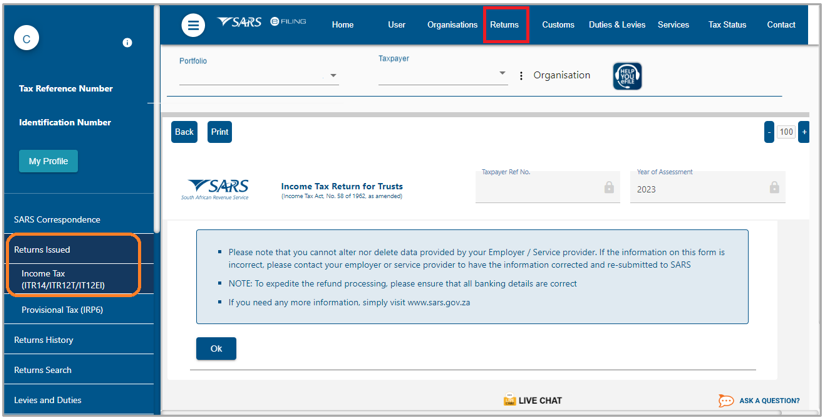
Tax Form Wizard (ITR12T) Page
Standard and Comprehensive questions will be displayed as the first page of your Trusts ITR12T return. This wizard will aid in creating your customised Trust return.
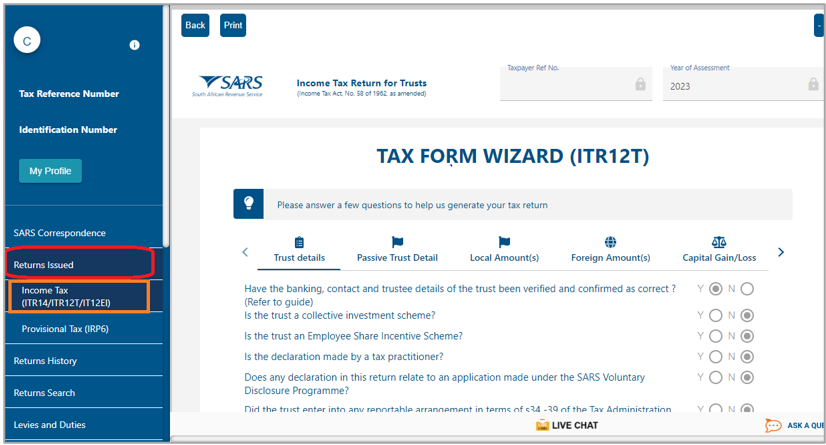
Complete all the wizard questions to create the required containers in the ITR12T return.
- Helpful hints to note whilst completing the ITR12T return:
- All mandatory fields on the ITR12T will be indicated in red.
Note: If mandatory fields are not completed, an error message will be displayed and that implies that you will not be able to submit the ITR12T until it is completed.
- Depending on the answer provided to each question, subsequent questions may be displayed.
- Answer all the questions before commencing with the completion of the return.
- Click the “Continue” button to commence to the next question on the wizard or the “Back” button to proceed to previous question on the wizard.

- If any of the questions are changed after starting to complete the return, it may result in the following:
- Existing sections on the return may be removed. The form will display a warning message to alert you of any potential loss of data captured; or
- Additional sections may be displayed on the return for completion.
Refer to the “Find a source code” tab on the SARS website to complete the source codes.
Once all the wizard questions have been completed, you will be presented with the “Continue to Form” button to proceed to complete the return.
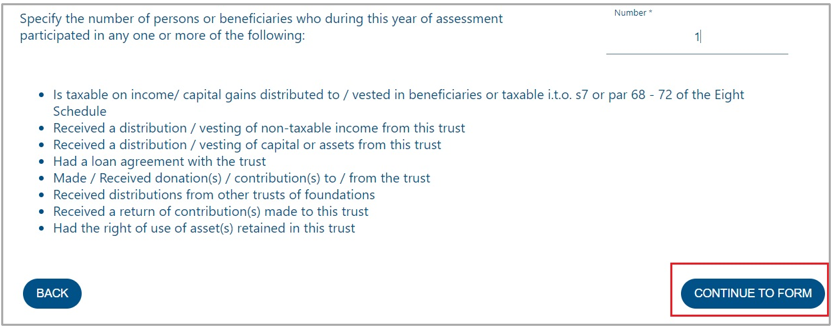
Refer to the Comprehensive Guide to the Income Tax Return for Trusts (ITR12T)s – External Guide on the SARS website for detailed information on how to complete the Trusts return.
The following will also be displayed on your screen:
- The “Quick Links” menu will be displayed on the far right of your screen. This menu may be used to access sections/ containers of the ITR12T Trust return. Each icon represents sections of the Trust return based on what has been completed on the wizard. Below is an example of the “Quick Links” menu.
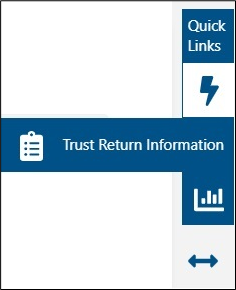
- Upon scrolling down, you will be routed to your created ITR12T Trust return.

- Complete the fields on the ITR12T Trust return as per external comprehensive Trusts guide.
Note to open each container/section of the ITR12T Trust form click on the “Arrow” ![]() or “Arrow”
or “Arrow” ![]() to close.
to close.
- The ITR12T will be pre-populated with the minimum demographic information of the Trust.
- After completing the ITR12T return, you may choose to Save the return by selecting the “Save” tab and click “Continue” on the below message to return to the main menu of the ITR12T return.

- If all the mandatory fields are not completed, the menu tabs will be outlined in red showing that information still needs to be completed.
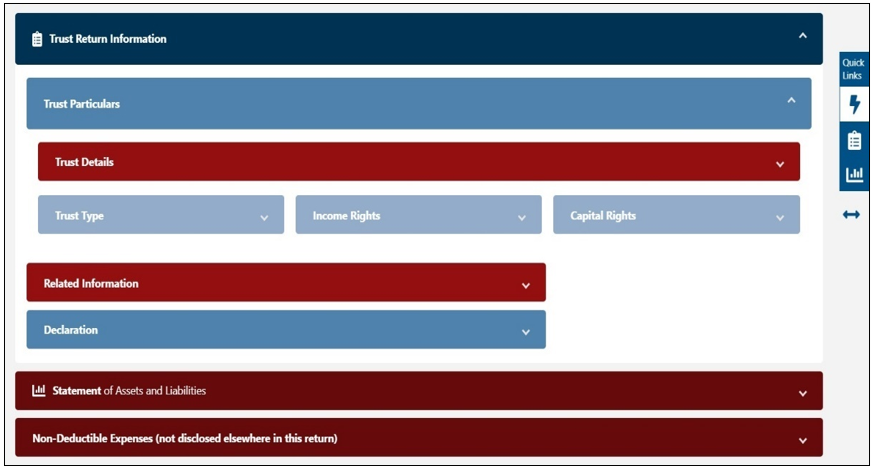
- After completing the ITR12T return, you may choose to Save the return by selecting the “Save” tab and click “Continue” on the below message to return to the main menu of the ITR12T return.

- Click “Continue” to proceed and the Income Tax Work Page status will be updated to indicate that the ITR12T is saved as indicated in the below screen.
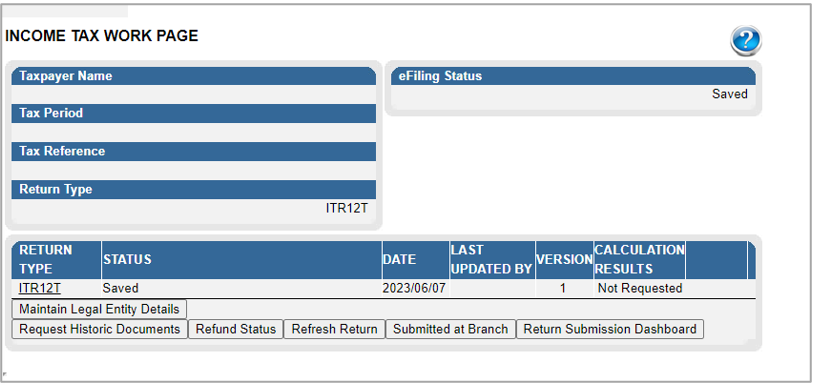
- The following buttons will be available for selection, namely “Back”, “Save”, “Submit Return to SARS”, “Calculate” or “Print” on eFiling.

- When all the required information has been provided on the return, click “Submit To SARS” to submit the return to SARS. The following message will be displayed upon successful submission to SARS.

- Click on “Continue” and the Income Tax Work Page will be displayed.
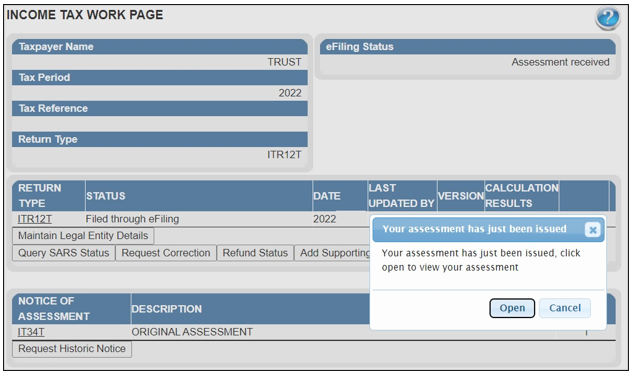
After submission of the return the following additional buttons will be visible to select:
- Query SARS Status – this button allows you to request the latest SARS status for the specific return.
- Request Correction – this allows you to correct the return that has been submitted. A saved version of the return will be displayed to perform corrections.
- Add Supporting Schedules – this allows the submission of supporting schedules.
Rejected Return Due to Invalid Tax Directive
If taxpayer/tax representative submit the Trusts return with a lump sum amount on a IRP5 certificate, SARS will perform verifications and one of the following messages may be displayed if the verification is unsuccessful and the return may be rejected:
- IRP5 Tax Directive Number invalid “Please note that this tax return was not processed, the Directive No.XXXXXXXXXXXXXXX captured on the IRP5 differs with the directive number issued by SARS. Please contact the Fund Administrator/Employer to rectify the error and resubmit the return.”
- IRP5 Lump sum accrual date invalid “Please note that this tax return was not processed because the accrual date on the IRP5 certificate does not match the one issued by SARS, on Directive No. XXXXXXXXXXXXXXX. You can access a copy of the Tax Directive on eFiling or MobiApp. Urgently contact the Fund Administrator/Employer to correct the error and submit the corrected tax return.”
- IRP5 Lump sum source code Invalid “Please note that this tax return was not processed because the Lump Sum source code on the IRP5 certificate does not match the one issued by SARS, on Directive No. XXXXXXXXXXXXXXX. You can access a copy of the Tax Directive on eFiling or MobiApp. Urgently contact the Fund Administrator/Employer to correct the error and submit the corrected tax return.”
- IRP5 Lump Sum amount invalid “Please note that this tax return was not processed because the Lump Sum amount on the IRP5 certificate does not match the one issued by SARS on Directive No. XXXXXXXXXXXXXXX. Urgently contact the Fund Administrator/Employer to correct the error and submit the corrected tax return.”
- IRP5 Lump sum amount missing “Please note that this tax return was not processed because SARS issued a Tax Directive No. XXXXXXXXXXXXXXX, but there is no Lump Sum amount declared on the return. You can access a copy of the Tax Directive on eFiling or MobiApp. Urgently contact the Fund Administrator/Employer to correct the error and submit the corrected tax return.”
- Directive number invalid for Taxpayer “Please note that this tax return was not processed because SARS does not have a Tax Directive issued to the taxpayer. Tax Directive No. xxxxxxxxxxxxxxx on your IRP5 is invalid. You can access a copy of the Tax Directive on eFiling or MobiApp. Urgently contact the Fund Administrator/Employer to correct the error and submit the corrected tax return.”
Once the Fund Administrator or Employer has corrected the error either on the IRP5/IT3(a) certificate to correspond with the information on the tax directive or the directive has been corrected to correspond with the information on the IRP5/IT3(a) certificate with SARS, you will be able to proceed to submit the Trusts return. Ensure that you refresh the IRP5/IT3(a) data before completing the return.
Uploading Supporting Documents with your ITR12T Return
- When submitting a Trust return, supporting documentation is required to determine whether the ITR12T submission should include supporting documents/schedules, the Trust representative must evaluate the nature and the activities of the Trust and determine which schedules are required. Refer to the Comprehensive Guide for mandatory documents that should be submitted with the return.
- eFiling permits the Trust representative to upload these schedules and all relevant supporting documents together with the ITR12T return. However, note that documents can only be uploaded once the ITR12T return has been filed.
- Ensure that the following standards are adhered to when supporting documents are uploaded:
- The file type may be .pdf, .doc, .docx, .xls, .xlsx, .jpg and .gif to enable SARS to view the documents.
- The maximum allowable size per document may not be more than 5MB and a maximum of 20 documents may be uploaded.
- Below are screens demonstrating how to upload supporting documents/schedules on eFiling.
- On the “Income Tax Work Page” screen, click on the “Add Supporting Schedules” or the Supporting Documents hyperlink will be displayed on the Income Tax Work Page.
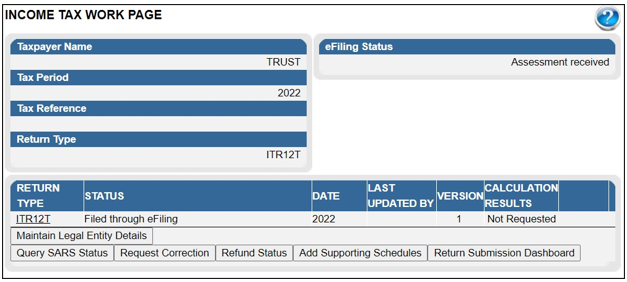
- Click on “Return Submission documents”.

- Once the above conditions are met and the “Related Information” questions in the return are marked “Yes” for one or both questions, you will be able to complete all mandatory fields and submit the return. Once the return has been submitted, the following screen will be displayed to inform the user that the supporting documents will be submitted.
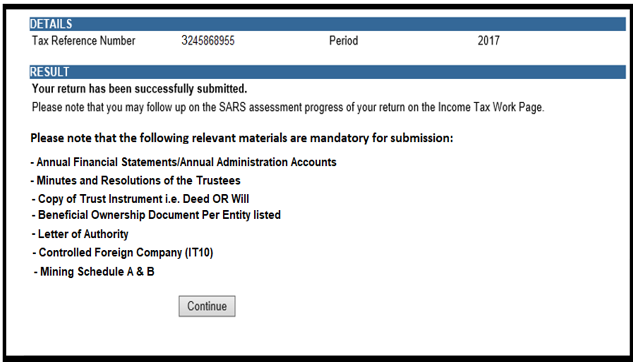
- Click “Continue” and on the “Income Tax Work Page”, the “Compulsory supporting documents” hyperlink will be available to submit the relevant supporting documents.
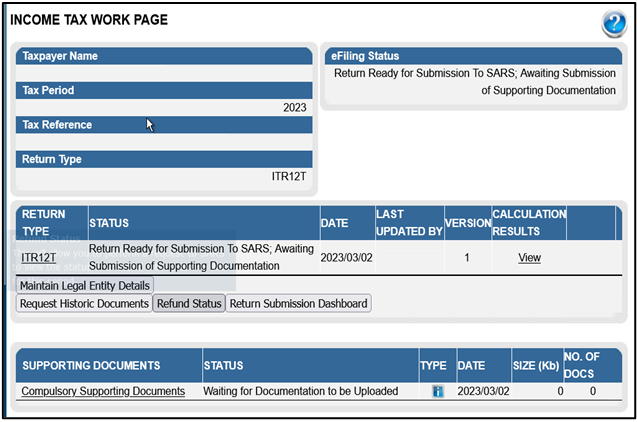
- Click on either the “Return Submission Documents” or “Compulsory Supporting Documents” hyperlink and the following new landing page screen will appear.
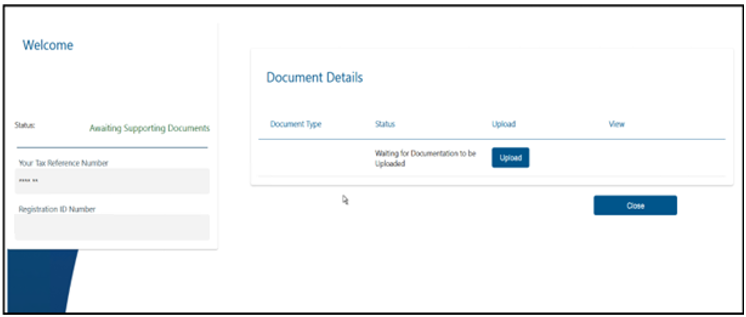
- New landing page will be displayed to upload the supporting documents:
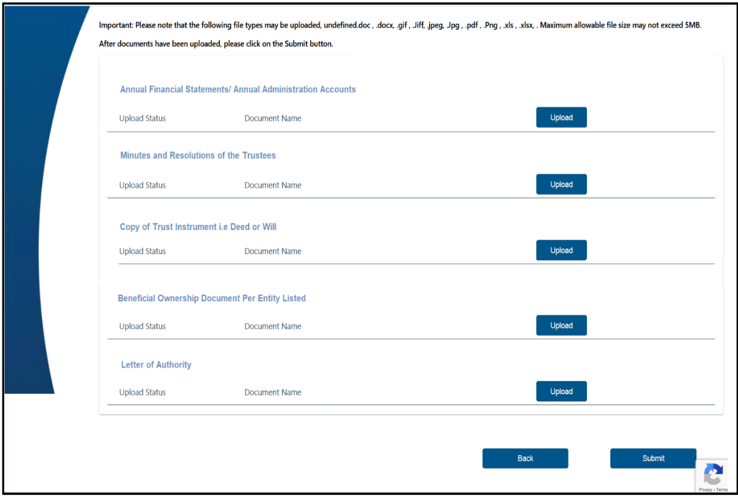
- Upload the required supporting documents and click ‘OK’,
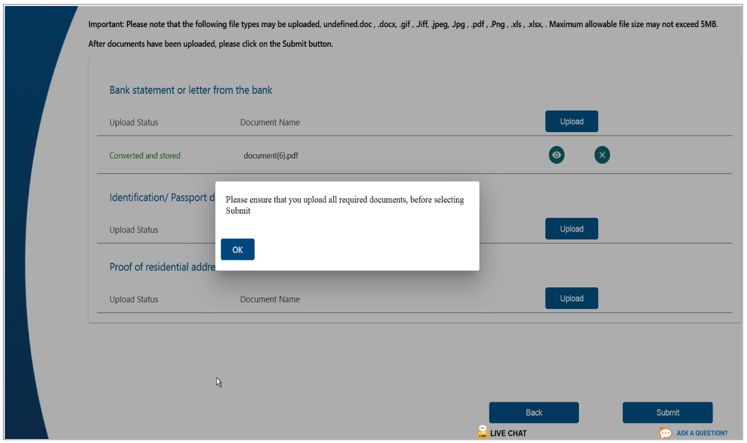
- Once the required supporting documents are uploaded, a pop-up message will be displayed, “It is important that you upload all the documents requested by SARS before you submit in order to eliminate any delays in processing your return, if there is any documents still missing after submitting this return, please use “Add Supporting Schedules” function on your work page to submit them click “Continue” to submit.”
- Once the required supporting documents are all uploaded click ”Continue” to proceed or ”Cancel” if supporting documents are not uploaded as per request and you will be redirected to supporting documents landing page.
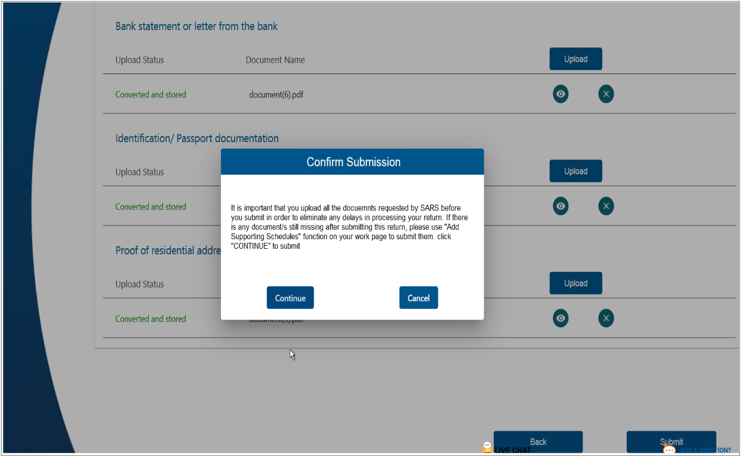
- Once all the supporting documents have been uploaded, click on “Submit”. A message will be displayed to confirm that you have uploaded all the required documents before submitting to SARS.
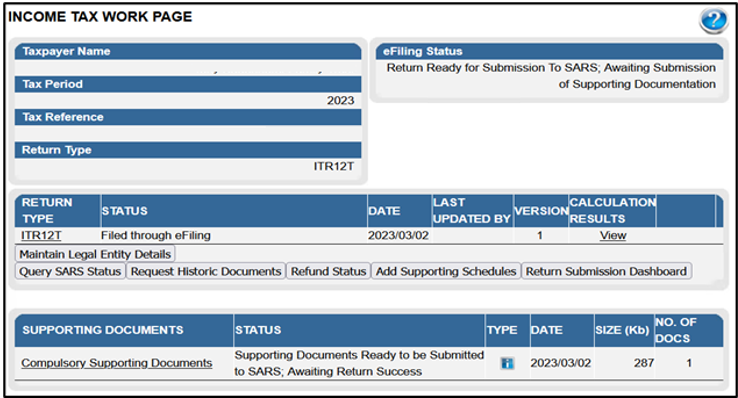
- Once you have submitted the relevant documents, the status on the Supporting Documents section on the “Income Tax Work Page” will be updated to “Submitted”.
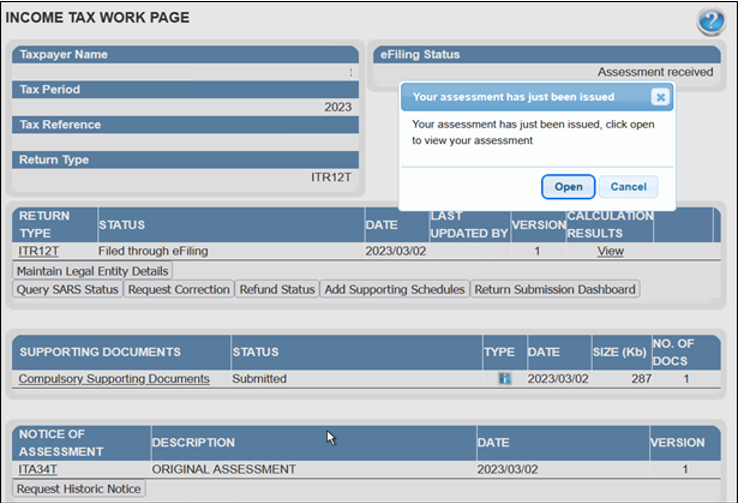
- When uploading compulsory supporting documents, once the documents have been uploaded and submitted as explained above, the return will be submitted to SARS and the “Income Tax Work Page” will be updated with the relevant status.
Submitting your ITR12T Early
- Taxpayers /Tax practitioners are encouraged to file their return during the official Filing season phase for a Trust. The filing dates are published under “Public Notices” on the SARS website.
- In an event, that a taxpayer/ tax practitioner request a return for a Trust prior to the Filing season period, eFiling will display the following message.

Note that a similar message will be displayed when you request a return for Exempt Institutions that are registered as Trusts prior to the Filing season period.
- Take note of the message and click the Ok button to proceed.
Additional Functions on the Income Tax Work Page
This section will take you through the functions that are found on the Income tax work page and illustrate how you can use them for submission purposes.
How to Request Historic Trust Submission
To request historic submissions, proceed as follows:
- Click on “Return” displayed on the top menu.
- Click on “Return History” displayed on the left side menu.
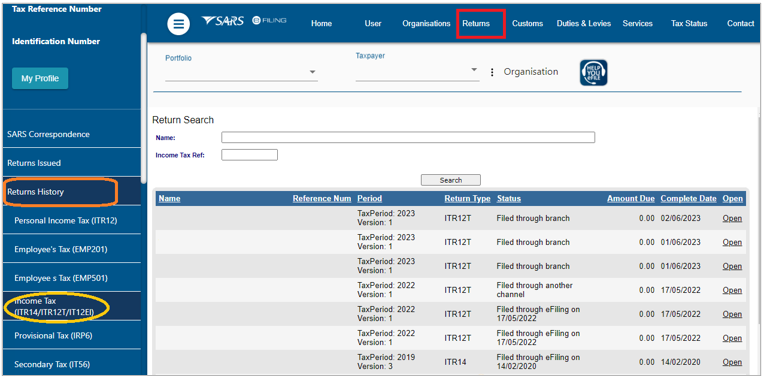
- Click on “Income tax (ITR14/ITR12T/ITR12EI)”.
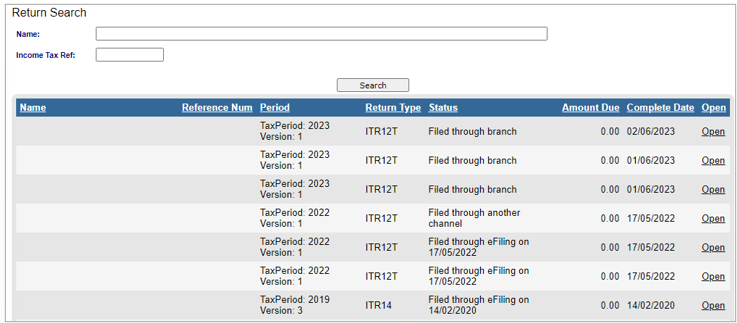
- Select the hyperlink “Open” and the “Income tax work page” will be displayed.
Request Correction
This function allows you to request a correction on the previously submitted ITR12T form and re-resubmit it to SARS.
However, a request for correction will not be permitted in the following instances:
- If the return is on issued or saved state.
- If an active verification is in progress and one allowable RFC must be submitted.
- An active audit case is in progress.
- An agreed estimated or SARS estimation of an original return was performed by SARS for the Trusts.
- SARS has finalised an audit case or a Revised Declaration for the Trust.
- If supporting documents for an active verification case have been submitted.
If the Trust representative does not agree with the assessment, a notice of objection must be lodged.
Once the “Request Correction” has been submitted, no action will be taken on the previous return submitted, as it will be replaced by the new return.
On the “Income Tax Work Page” click on the tab, “Request Correction” displayed as one of the tab buttons below “ITR12T”.

- An additional row will be displayed on the “Income Tax Work Page” where the status is recorded as “Saved” and version is recorded as 2.

- Click “ITR12T” of the second version.
Note that the version number is dependent on the number of corrections requested.
- Upon the selection of “ITR12T”, the ITR12T return will be displayed.
- Complete and submit the ITR12T return accordingly.
- Once you have filed the updated return, the “Income Tax Work Page” status will indicate that the ITR12T return has Filed through eFiling.
Request Historic Documents
- All returns filed to SARS are stored under “Returns History” under “Returns”. This function should be used to request historic information on your assessments.
- On the “Income Tax Work Page”, select “Request Historic Notice”.

- The “Request historic Issued Assessment Notices and Statement of Account” screen will be displayed.
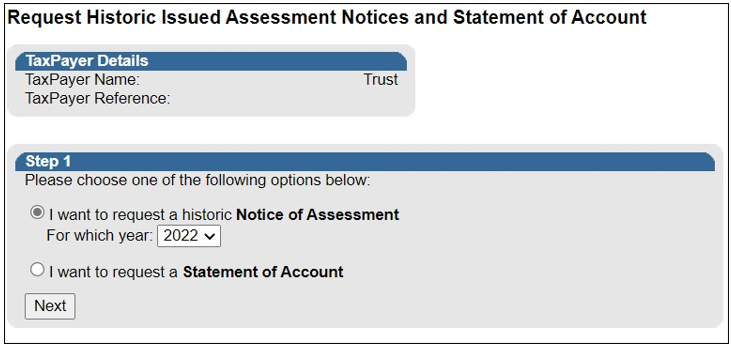
- Select the appropriate year and click “Next” displayed at the bottom of the screen.
- The “Request Historic Issued Assessment” screen will be displayed indicating the selection of the year made.

- Click “Request” to continue.
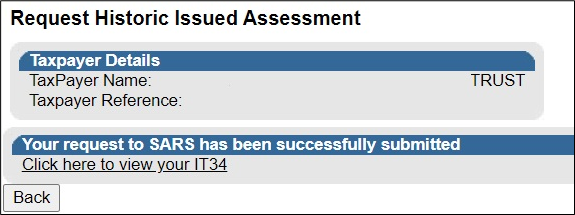
- Select “Click here to view your IT34” or click on “Back” to amend the chosen period.
- This will take the user to the ITA34T for the period of interest.
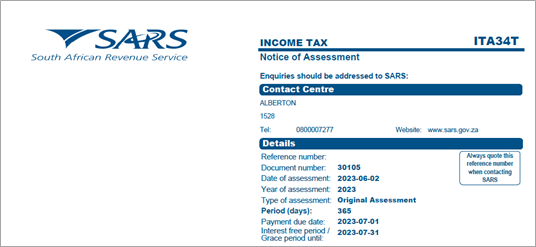
Query SARS Status
- This function should be used when enquiring the status of your ITR12T return.
- On the “Income tax work page” click on the tab button “Query SARS Status”.

- Depending on the status of the ITR12T, the screen that will be displayed will vary. Below is an example of one of the statuses.

Refresh Return
- This function is to be used to update data.
- On the “Income Tax Work Page”, select “Refresh Return” tab.

- Upon selecting the “Refresh Return” tab, the following warning message will be displayed.

- To refresh the return, select the option(s) that is applicable.
- Click on “OK”.
If there is Lumpsum information available for the Trust, the following fields will be updated on the ITR12T return in the wizard section and on the “Lump Sum Benefits Received or Accrued” section, for each iteration of lump sum details:
- Lump sum Benefits Received or Accrued;
- How many lump sum benefits were received or accrued?;
- Gross Lump Sum (as per IRP5/IT3(a)) – Source Code 3915;
- Tax Directive Number (as per IRP5/IT3(a) certificate);
- IRP5/IT3(a) Certificate Number;
- PAYE on Lump sum Benefit.
The following message will be displayed indicating that your return was successfully refreshed.

- Click on “Continue” and you will be directed to the “Income Tax Work Page”.

Refund Status
- This function may be used to check if you have a refund.
- On the “Income Tax Work Page”, click on “Refund Status”.

Submitted at Branch
- This function is to be used if you have submitted your return at a SARS branch.
- On the “Income Tax Work Page”, click on “Submitted at Branch”.

- The following message will be displayed.

- If the user selects “OK”, the status will be changed to filed through another channel.

Request a Statement of Account
- This section will demonstrate how to request a statement of account. On the “Income Tax Work Page”, under the Notice of Assessment section, click the “Request Historic Notice” button.

- Select “I want to request a Statement of Account” and click “Next”.
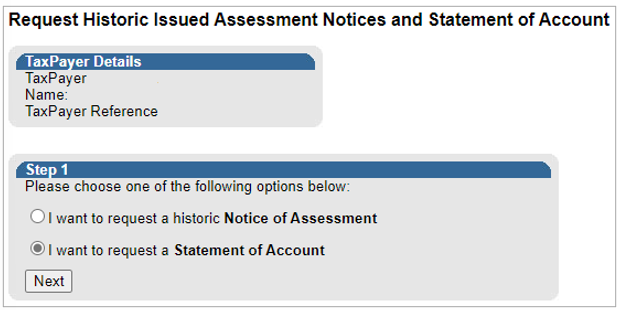
- Click the “6 months to date” option and “Request”.
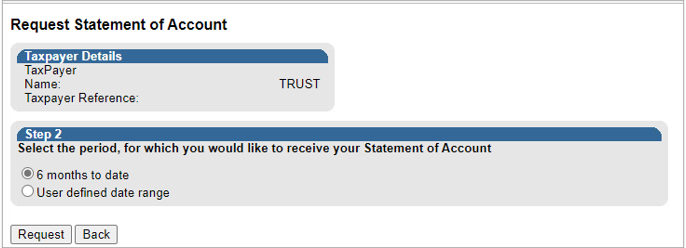
- Click on the hyperlink to view the statement of account for the ITR12T.
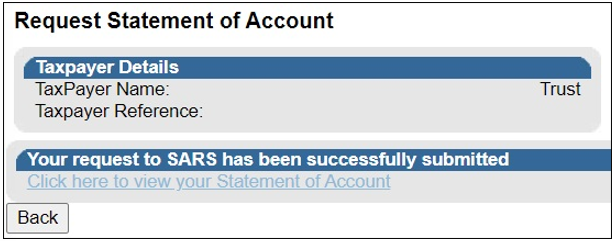
- Below is an extract of the statement of account.
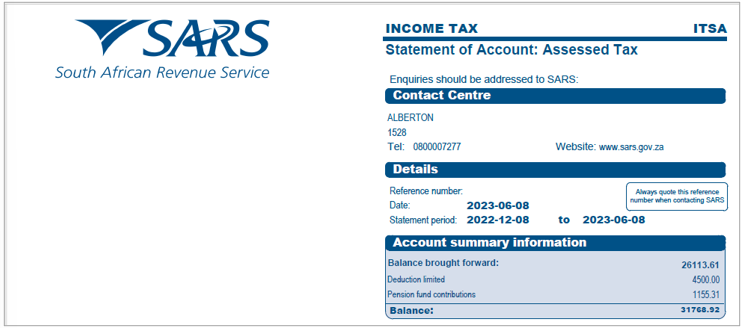
View Return Submission Dashboard
- This function will allow you to view your dashboard information.
- On the “Income Tax Work Page”, click on “Return Submission Dashboard”.

- The following screen will be displayed.
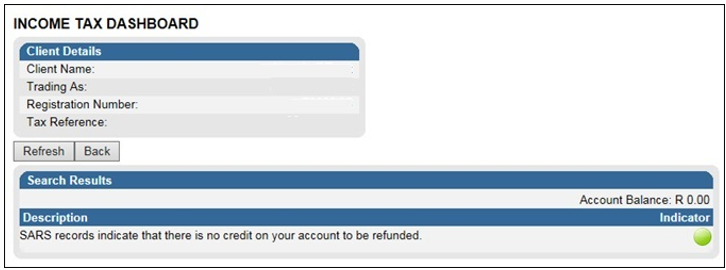
- Red – The taxpayer is required to action as per SARS status displayed.
- Amber – SARS is in progress with an action.
- Green – No action is required.
- If no indicators returned, the screen below is displayed.
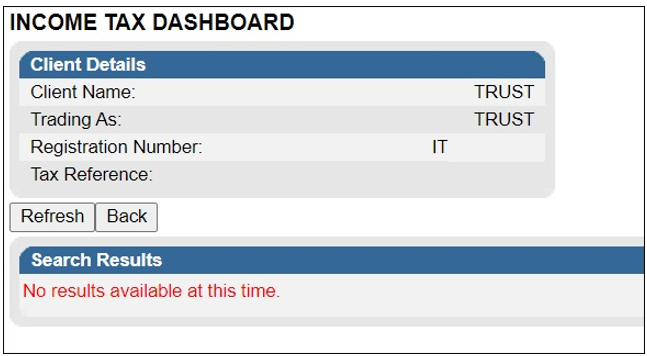
Maintain Legal Entity Details
- This function is to be used when updating legal entity details of the Trusts representative such as contact details, banking details etc.
- On the “Income Tax Work page”, click “Maintain Legal Entity Details”.

- The “Maintain SARS Registered Details” screen will be displayed.
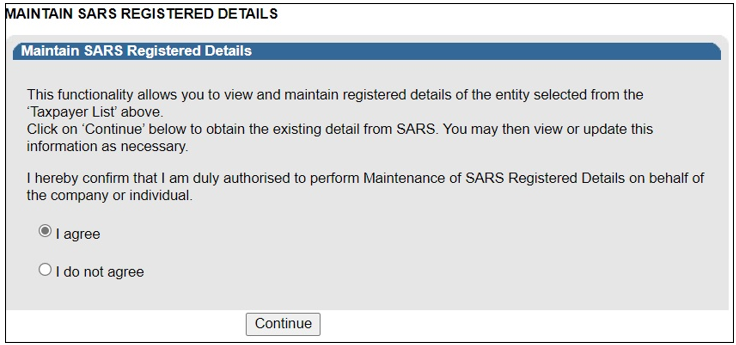
- Select “I agree” and click “Continue”.
- The “Saved Details” screen will be displayed if SARS have updated information for the Trusts.
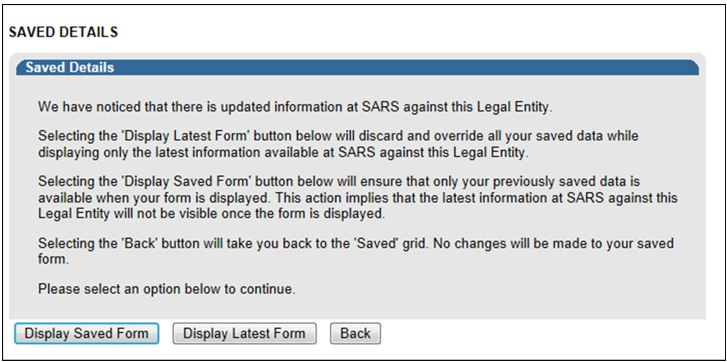
- If all the information of the Trusts is already updated, the RAV01 form will be displayed.
- Click on the appropriate form noting the warning message or select “Back” to go back to the “Maintain SARS Registered Details” screen.
SARS Notices
- To view notices or letters issued, under the “Returns” menu, select “SARS Correspondence”.
- Select “SARS Correspondence”, enter the tax type, tax year, and notice type.
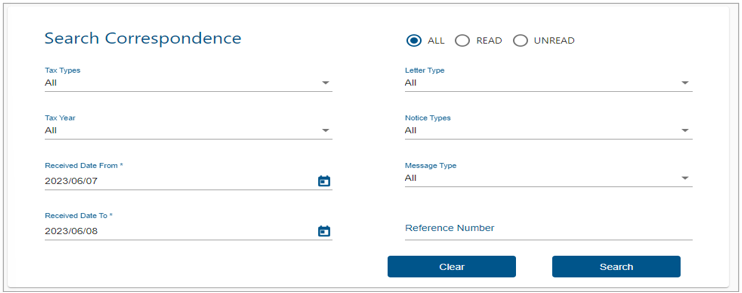
- Select applicable option on the “Notice Type” and click “Search” to continue. All notices issued by SARS will be displayed. Click the relevant “View” tab and the notice will be displayed.

Definitions, acronyms and abbreviations
The definitions, acronyms and abbreviations can be accessed here – Glossary webpage.
Legal disclaimer: In the event of conflict or inconsistency between this webpage and the PDF version of the guide, the latter shall prevail.
